Geyser Hill is a group of thermal features, including geysers, springs, and pools next to Old Faithful Geyser in Yellowstone's Upper Geyser Basin.
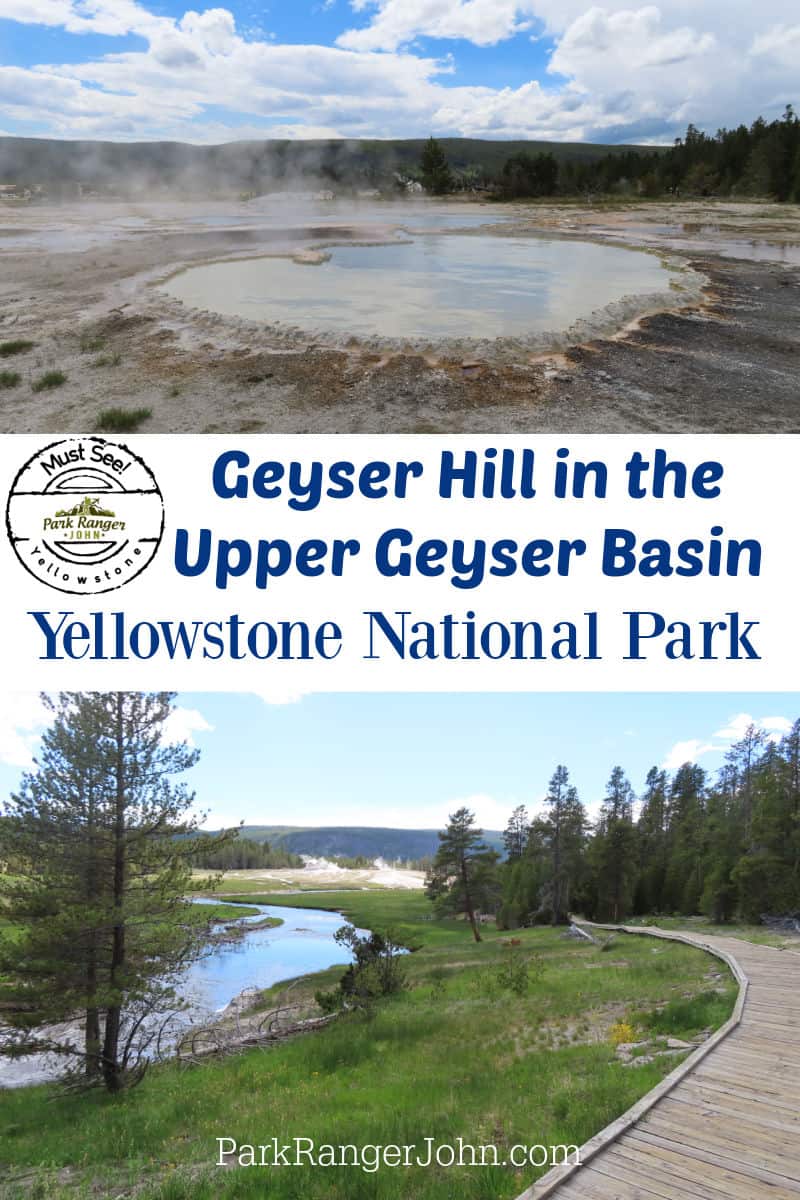
Geyser Hill in Yellowstone National Park
Geyser Hill is a must for any Yellowstone visitor. It begins at Old Faithful and is a short boardwalk loop trail with over 50 of the 500 geysers in Yellowstone. This is very impressive considering the small area it is located within the Upper Geyser Basin, which is the fourth largest geyser field in the world!
I have listed below a dozen of my favorite and most popular Geysers on Geyser Hill, which I hope will make you want to visit Yellowstone in the future!
Location - From Old Faithful Geyser, begin counterclockwise around the geyser towards the Firehole River and Observation Point. The trail begins just past the Firehole River.
Trail Distance - .6 miles
Parking - In the Old Faithful Parking Lot in the Upper Geyser Basin
Tips for a safe visit -
- Always stay on trails and boardwalks. This area has places where there is a thin, breakable crust with scalding water underneath.
- Do not attempt to get near the hydrothermal waters, as they can exceed 200 degrees and can lead to severe injuries and possibly fatal burns.
- Watch children at all times
- Do not run, push, or shove.
- Do not scratch hydrothermal mats.
You should start your trip watching Old Faithful, after all, it's the icon of Yellowstone! After enjoying Old Faithful Erupt, head to Geyser Hill, where you will run into several springs, including Blue Star Spring, Chinese Spring, and East Chinaman Spring.
You can extend your hike to the Observation Point trail to Solitary Geyser and Observation Point, which is a great place to see Old Faithful erupt from a distance.
Another fun hike is to make a larger loop trail and start counterclockwise, beginning with Castle Geyser. Shortly after Castle Geyser, turn right toward Crested Pool and Sawmill Geyser. Afterward, take another right toward Geyser Hill, eventually ending back at Old Faithful.
Yellowstone National Park Entrance Fee
Park entrance fees are separate from camping and lodging fees.
Park Entrance Pass - $35.00 Per private vehicle (valid for 1-7 days from the date of purchase)
Park Entrance Pass - Motorcycle - $30.00 Per motorcycle (valid for 1-7 days from the date of purchase)
Park Entrance Pass - Snowmobile - $30.00 Entry for one driver and one passenger (valid for 1-7 days from the date of purchase)
Per-Person Entrance Pass - $20.00 Visitors 16 years or older who enter on foot, bicycle, or as part of an organized group not involved in a commercial tour.
Annual Park Entrance Pass - $70.00, Admits pass holder and all passengers in a non-commercial vehicle. Valid for one year from the month of purchase.
$20.00 for Non-Commercial Group (16+ persons)
$20.00 for Commercial Sedan with 1-6 seats and non-commercial groups (16+ persons) ($25.00 plus $20.00 per person)
$125.00 for Commercial Van with 7-15 seats
$200.00 for Commercial Mini-Bus with 16-25 seats
$300.00 for Commercial Motor Coach with 26+ seats
Learn more about National Park Passes for parks that have an entrance fee.
$80.00 - For the America the Beautiful/National Park Pass. The pass covers entrance fees to all US National Park Sites and over 2,000 Federal Recreation Fee Sites for an entire year and covers everyone in the car for per-vehicle sites and up to 4 adults for per-person sites.

Buy your pass at this link, and REI will donate 10% of pass proceeds to the National Forest Foundation, National Park Foundation, and the U.S. Endowment for Forestry & Communities.
National Park Free Entrance Days -Mark your calendars with the five free entrance days the National Park Service offers annually.
Remember that Yellowstone has an entrance fee separate from camping fees.
Fountain-type geysers are the most common type and have a pool, which is often mistaken for a hot spring, as opposed to a narrow vent like a cone geyser. Water passes through the pool before the eruption, creating a fountain look as opposed to the straight-up in the air force from a cone geyser.
Great Fountain Geyser is a great example of a fountain-type geyser.
Sinter: a geyserite or siliceous sinter is a form of opaline silica that is often found as crusts or layers around geysers and hot springs (source Wikipedia)
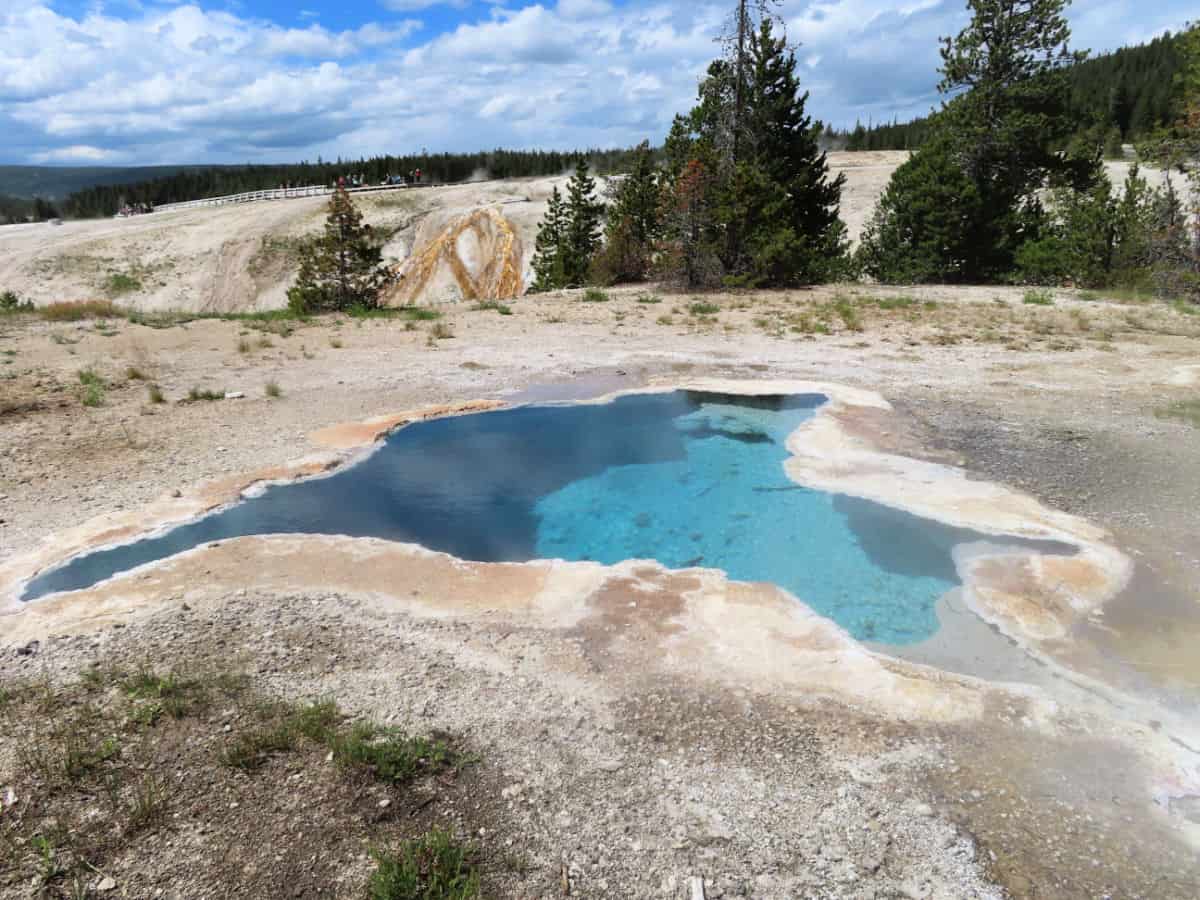
Blue Star Spring
Blue Star Spring gets its name from the shape of its blue pool surrounded by sinter. Eruptions are very rare; in fact, the last known eruption was back in 2002!
Average temperature: 190.7 degrees Fahrenheit.
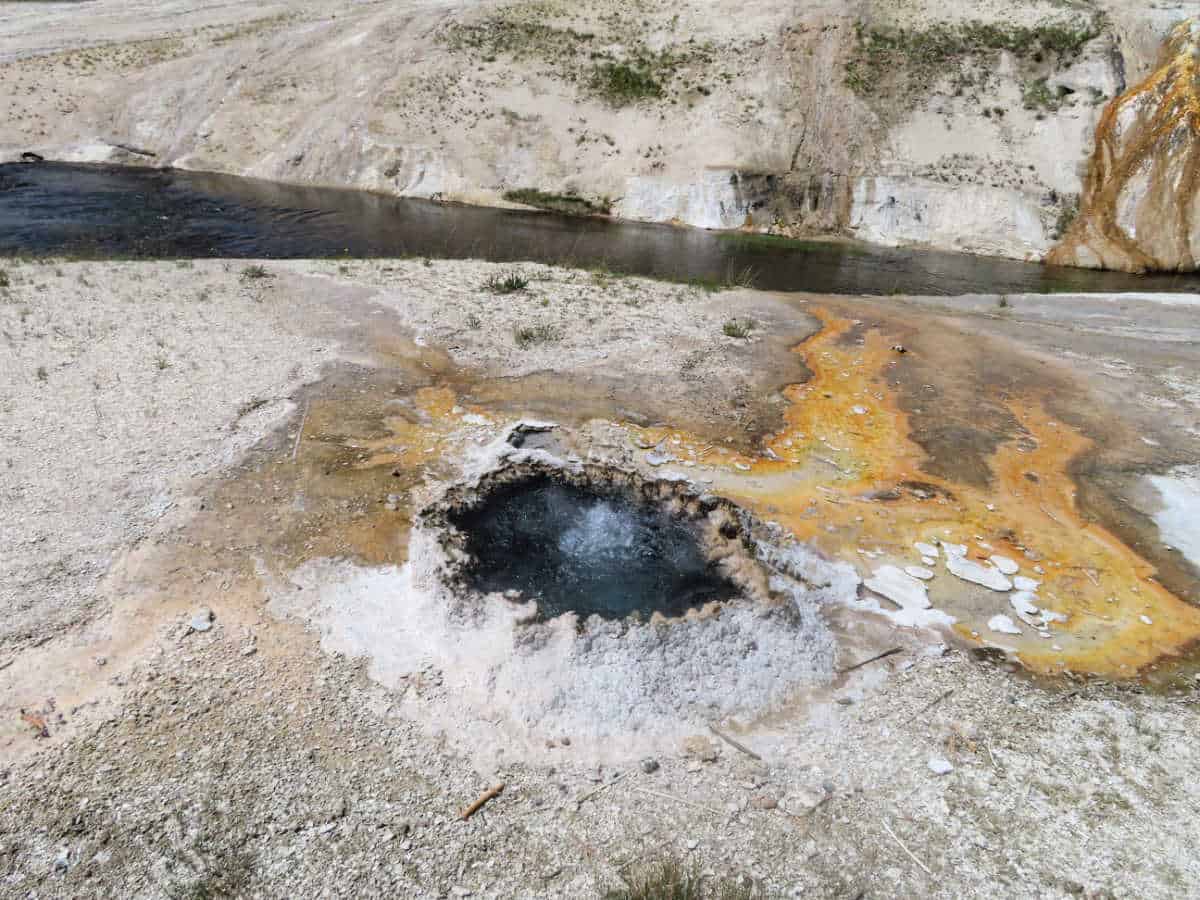
Chinese Spring
Chinese Spring gets its name from its past history of a Chinese immigrant who did their laundry (in the 1850's) in the spring when it erupted and threw their clothes into the air.
Chinese Spring will occasionally erupt up to heights of twenty feet.
Average temperature: 197.4 degrees Fahrenheit.
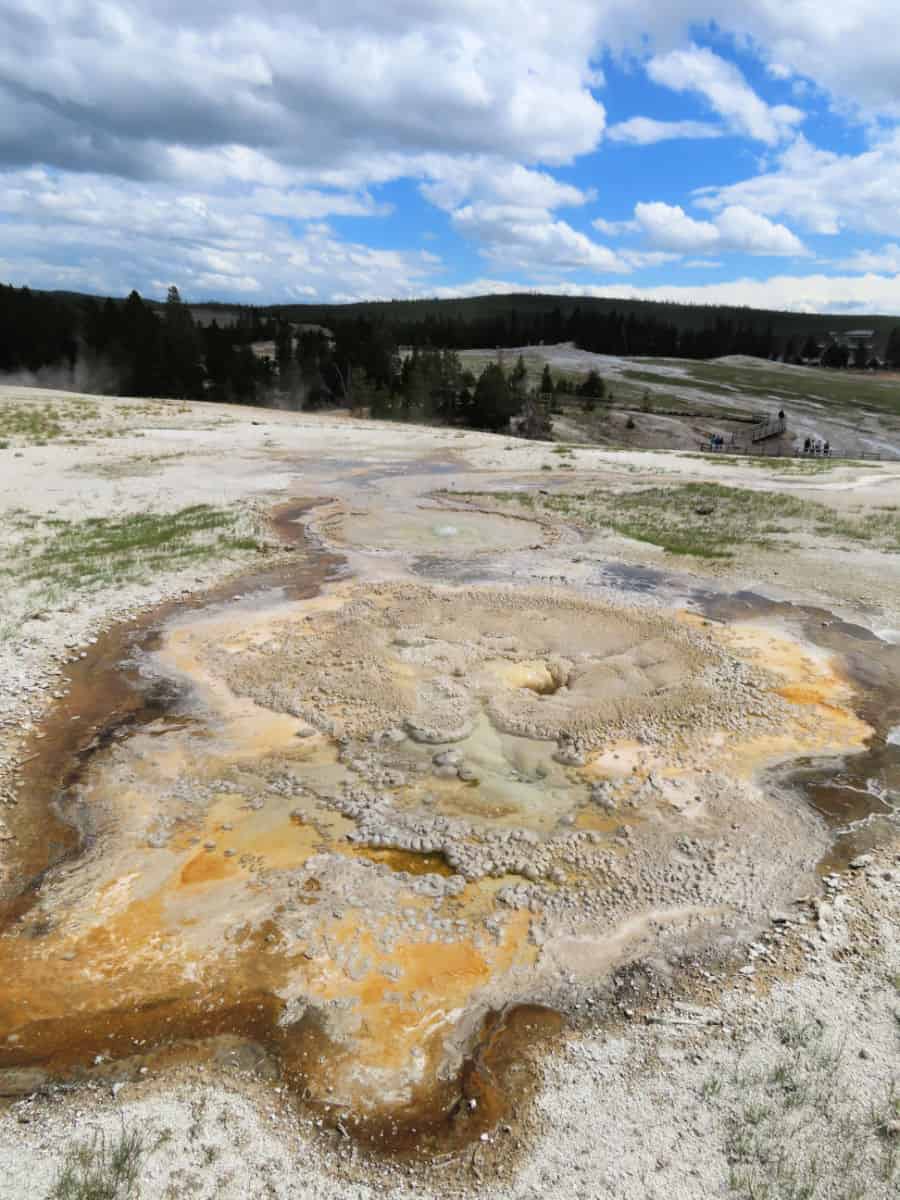
Anemone Geyser
Anemone Geyser is actually two geysers within ten feet of each other. It is likely named for the flower as both vents has a pale yellow color and shape of the flower.
Eruptions typically occur every seven to twenty minutes up to six to eight feet high and lasting 25 to 45 seconds.
Average Temperature: 184.8 Degrees Fahrenheit.
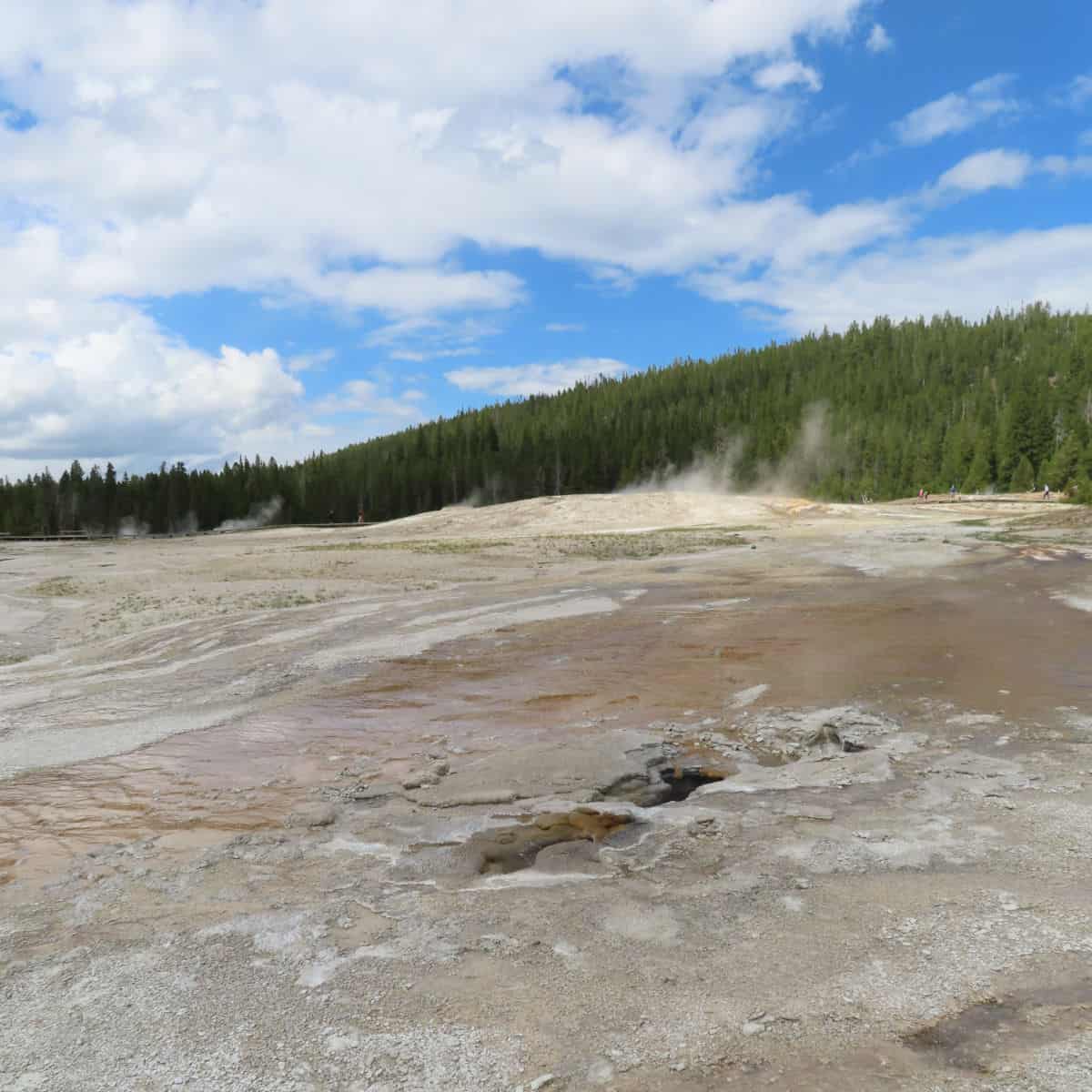
Plume Geyser
Plume Geyser was created in 1922 from a steam explosion, which created its vent. Another eruption in 1972 made the vent larger.
Plume Geyser changes its eruptions, but currently, it erupts every 20 minutes or so with 3-5 quick bursts up to twenty to twenty-five feet high.
Average Temperature: 191.2 degrees Fahrenheit.
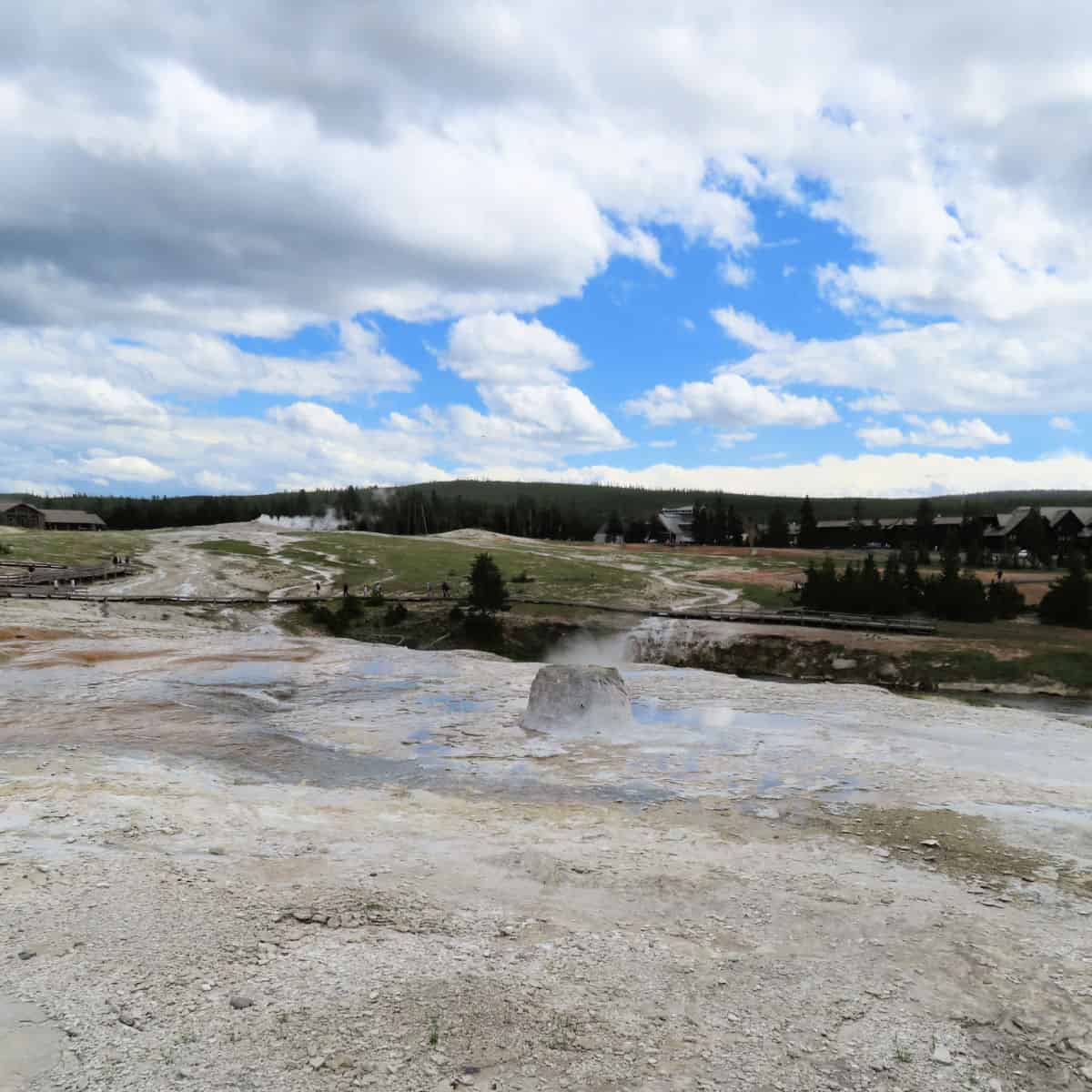
Beehive Geyser
Beehive Geyser is named because its four-foot-high silica cone is in the shape of a beehive.
Beehive Geyser is unpredictable, but it is rather impressive when it does erupt. It sends water to heights of 200 feet and lasts around five minutes!
When it becomes active, it will typically erupt 1-2 ties a day.
Average Temperature: 198.5 degrees Fahrenheit
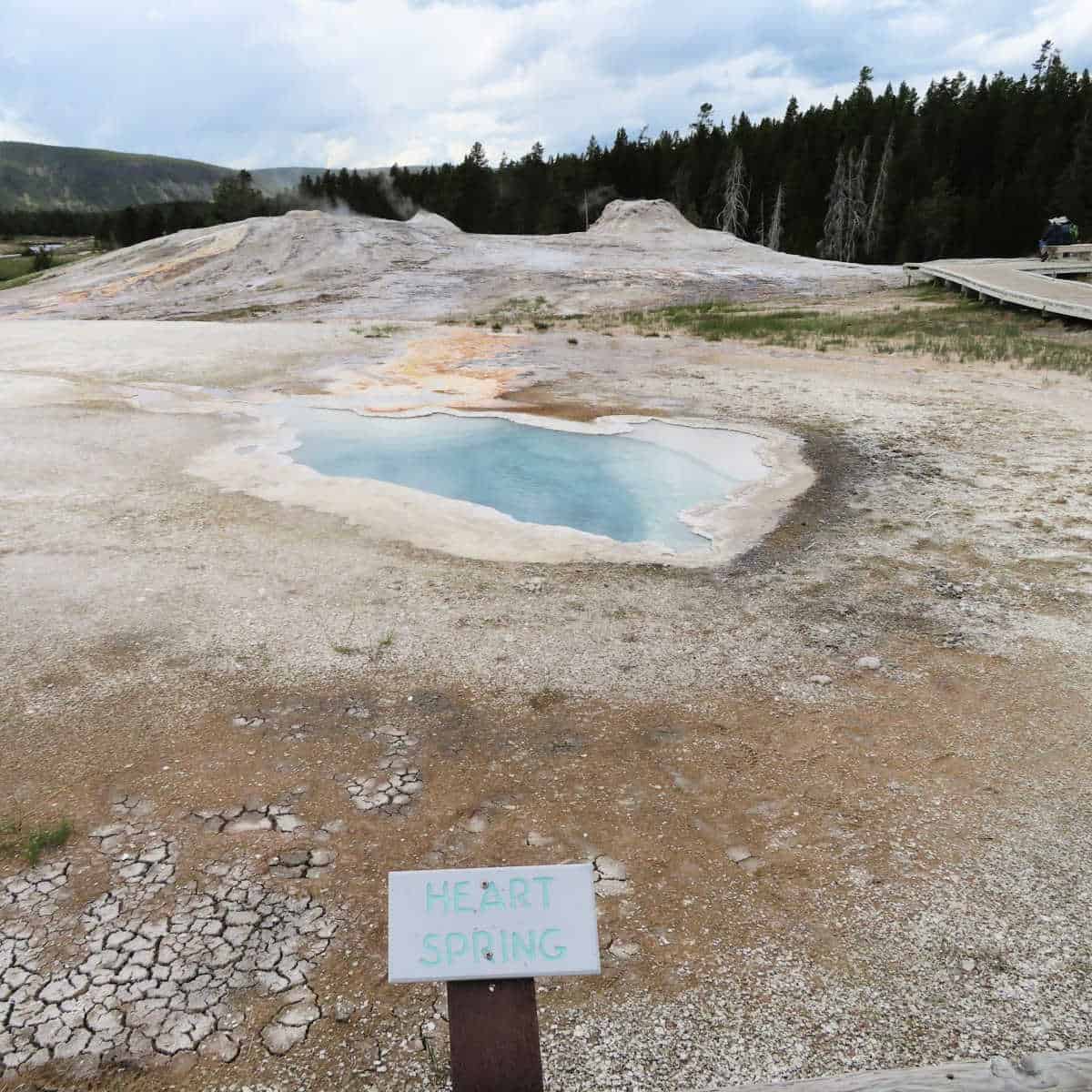
Heart Spring
Heart Spring is named because it is shaped like a heart. I have to admit, it immediately captured my attention! It has a fifteen-foot-deep pool and is considered inactive.
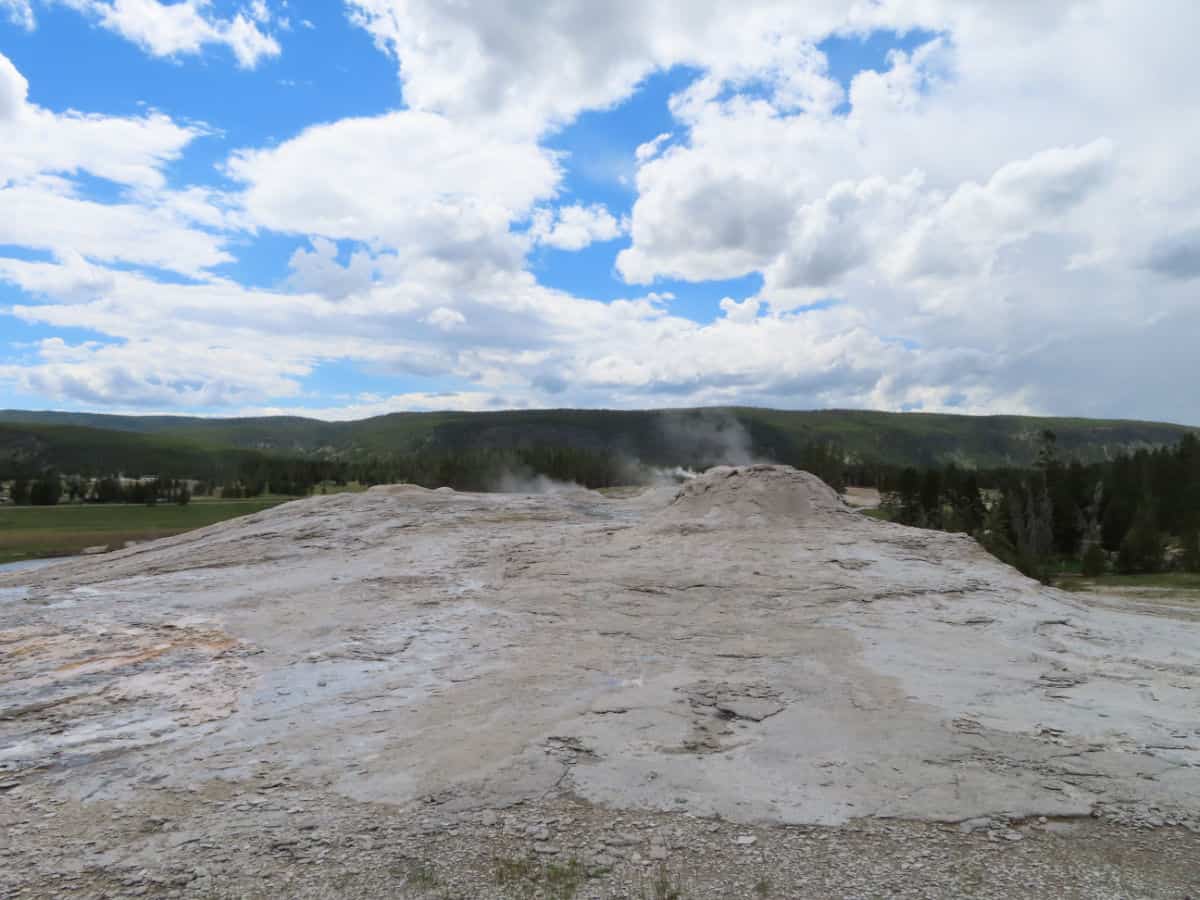
Lion Geyser Group
The Lion Group has three hot springs and four geysers, including Lion Geyser, Lioness Geyser, Big Cub Geyser, and Little Cub Geyser.
The Lion Geyser was named because of the sound it makes when steam is released during eruptions. Its eruptions can reach approximately ninety to one hundred feet high and last one to seven minutes. Between eruptions, the duration can be anywhere from six hours to several days.
Lioness and Big Cub Geysers rarely erupt, but if you get lucky, they can reach heights of fifty feet.
Average Temperature: 197.8 degrees Fahrenheit.
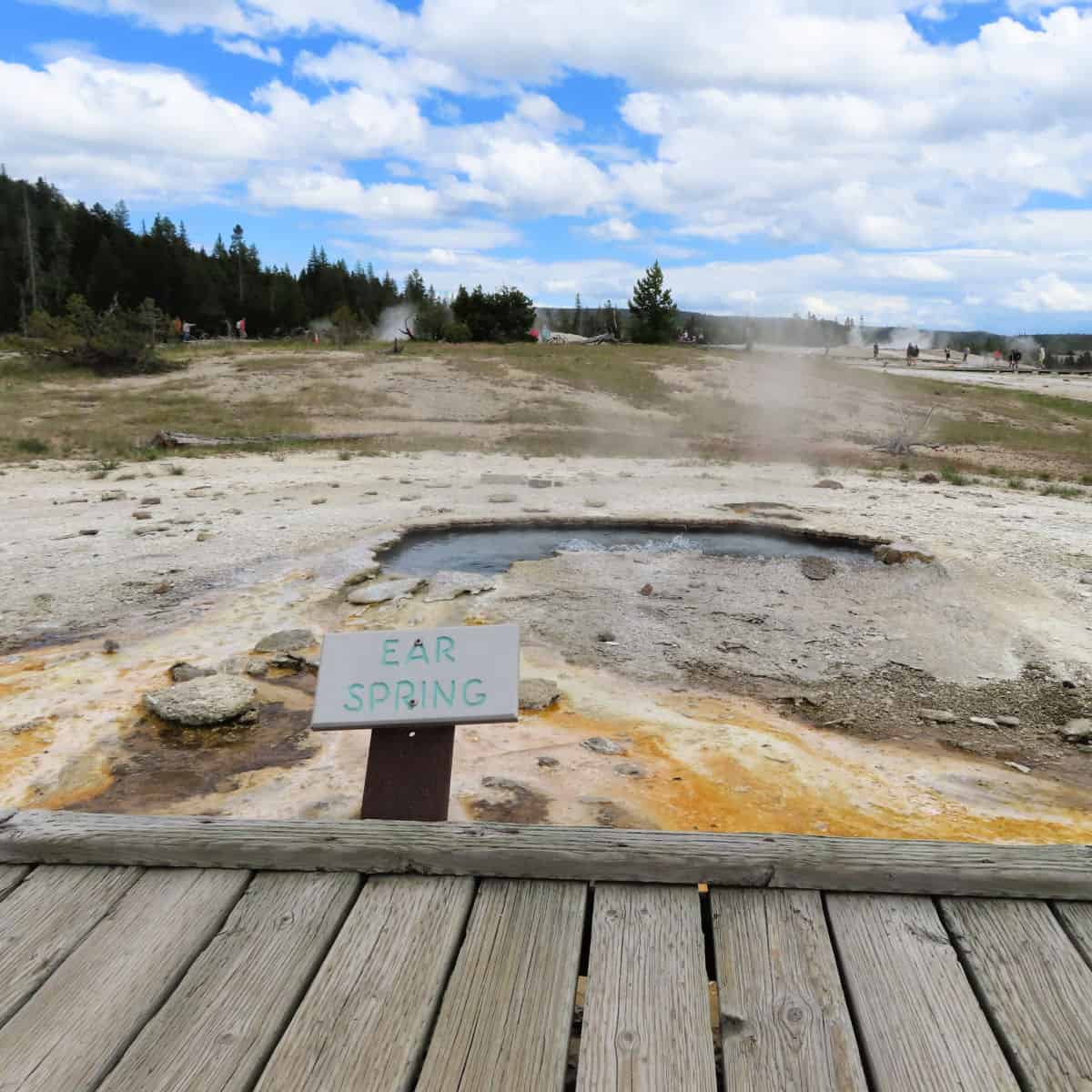
Ear Spring
Ear Spring is named because of its shape looks like an ear.
This normally quiet spring came to life in September 2018, gathering worldwide attention as it was the first eruption since 2004 and only the fourth time in forty years.
Consider yourself lucky to see this eruption and enjoy its eruption sending water twenty to thirty feet in the air.
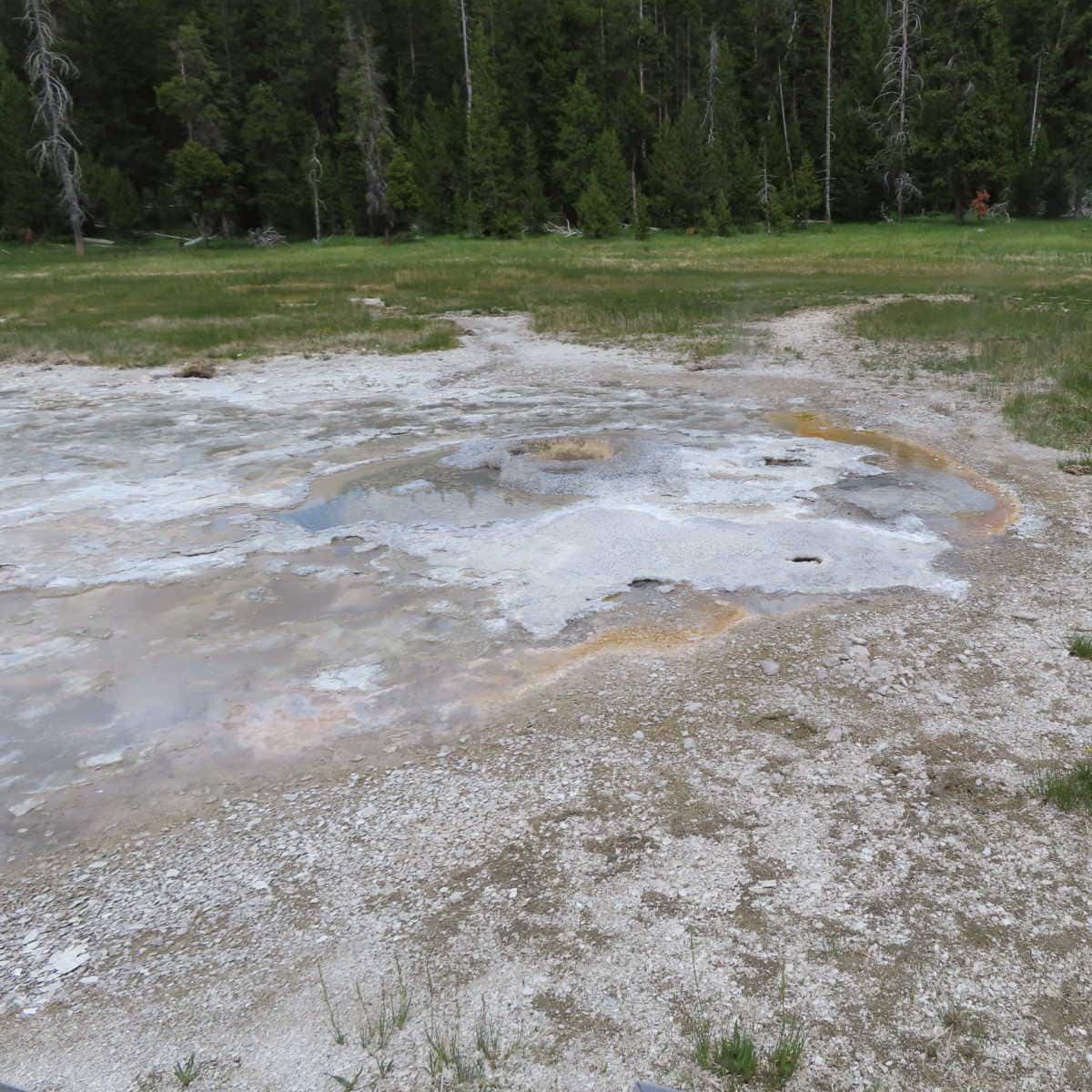
Aurum Geyser
When you look at Aurum Geyser, the first thing you will notice is the coloring around this cone-type geyser.
The coloring comes from the iron oxide that settles after each eruption that occurs every two and a half to seven hours.
Iron oxide gives it a gold color, which is why it is named Aurum, the Latin word for gold.
Eruptions can last up to sixty seconds to ninety seconds and reach heights of twenty to twenty-five feet.
Average Temperature: 196.7 degrees Fahrenheit
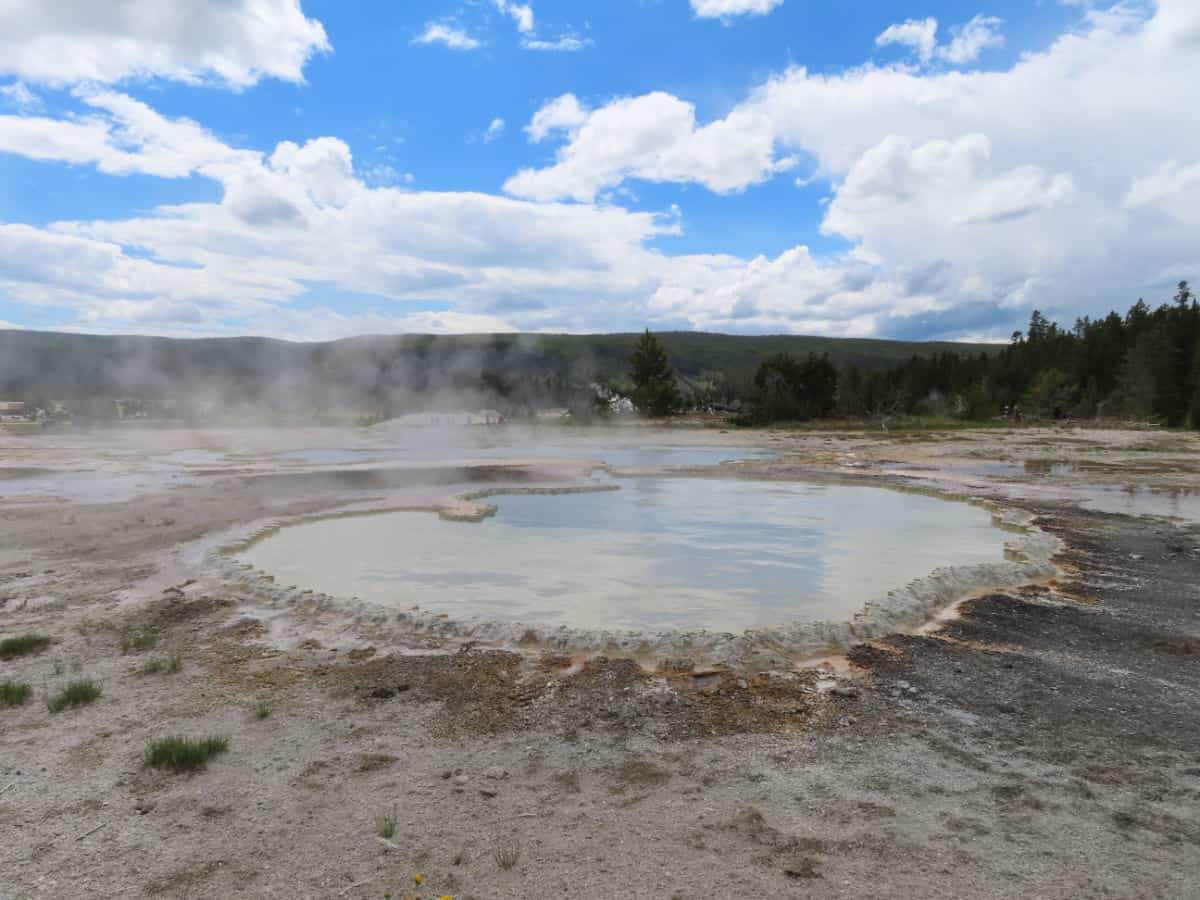
Doublet Pool
Doublet Pool is, in reality, two pools connected together. They are easily identifiable with their geyserite/siliceous sinter edge. The pools are eight to twelve feet deep and rarely erupt, with eruptions two to three feet high.
Average Temperature: 187.8 degrees Fahrenheit.
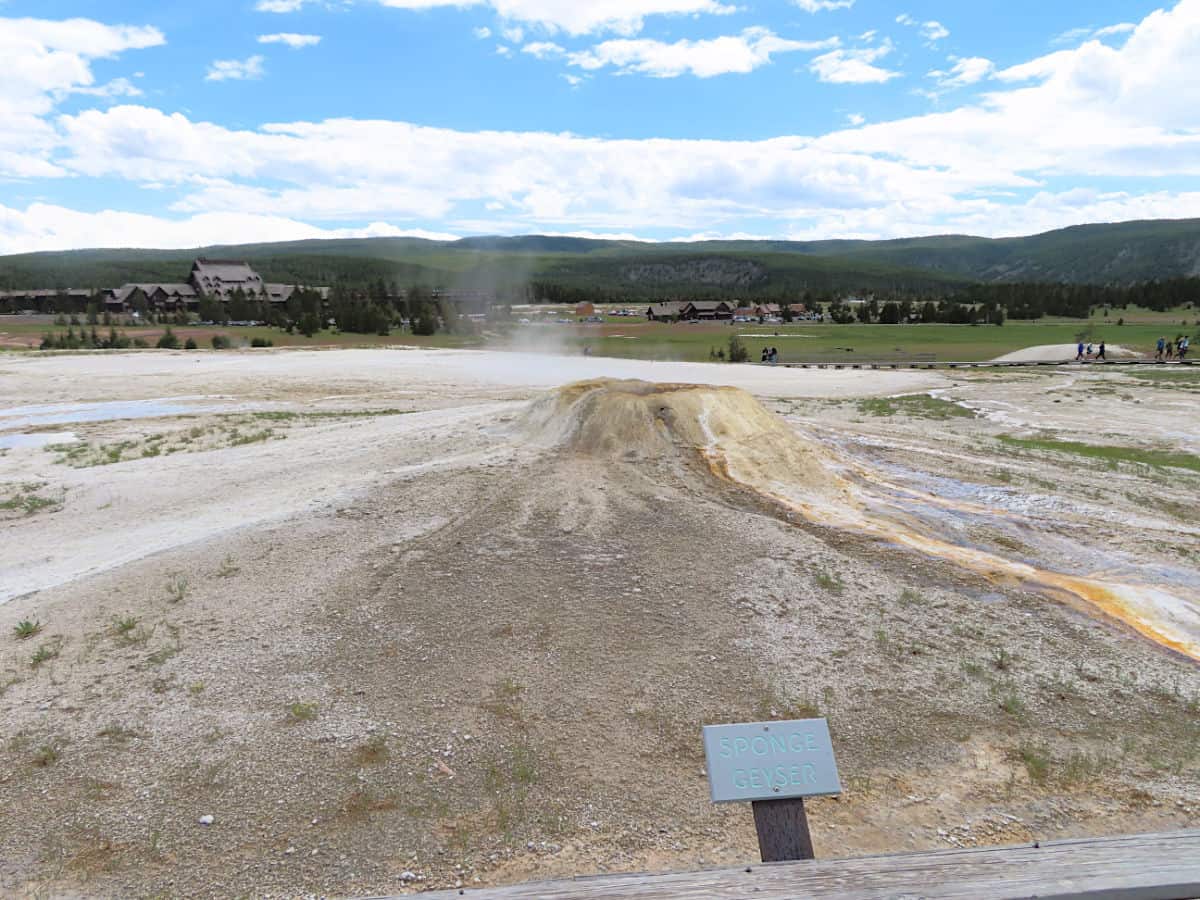
Sponge Geyser
Sponge Geyser is named because of its appearance of a sponge.
Sponge Geyser has very active eruptions reaching one to two feet high lasting up to one minute. It has similar intervals between eruptions.
Average Temperature: 199.0 degrees Fahrenheit.
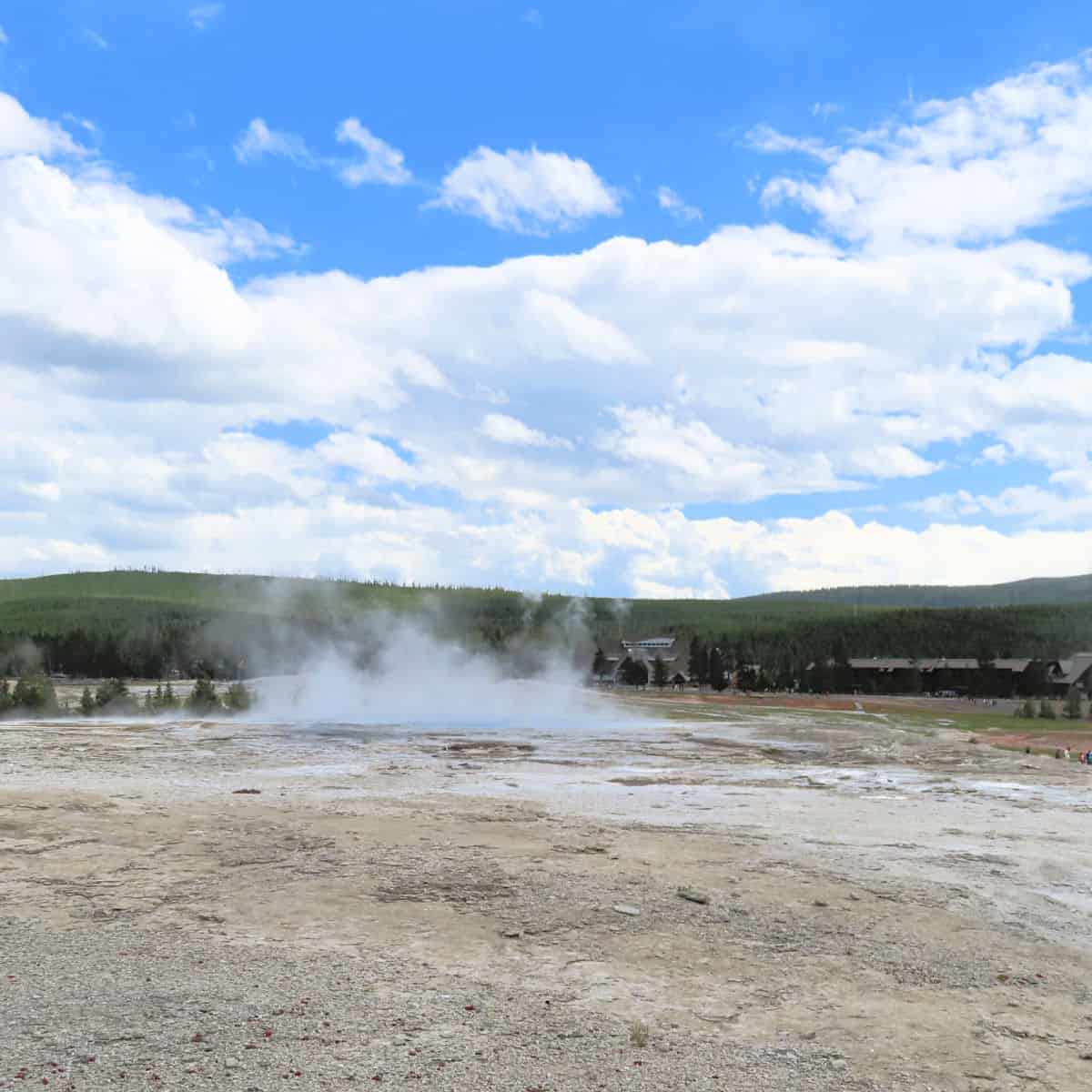
Giantess Geyser
Giantess Geyser was named by Nathaniel Langford of the 1870 Washburn Expedition as it was the tallest of all the geysers they saw on their expedition.
Giantess Geyser is unpredictable and can erupt between 0-41 times a year. The impressive part is seeing this geyser come to life as it can send water 200 feet into the air!
Average temperature: 196 degrees Fahrenheit.
Don't forget to pack
Insect repellent is always a great idea outdoors, especially around any body of water.
We use Permethrin Spray on our clothes before our park trips. Please read my article on preventing biting insects while enjoying the outdoors.
Sunscreen - I buy environmentally friendly sunscreen whenever possible because you inevitably pull it out at the beach.
Bring your water bottle and plenty of water with you. Plastic water bottles are not sold in the park.
Sunglasses - I always bring sunglasses with me. I personally love Goodr sunglasses because they are lightweight, durable, and have awesome National Park Designs from several National Parks like Joshua Tree, Yellowstone, Hawaii Volcanoes, Acadia, Denali, and more!
Click here to get your National Parks Edition of Goodr Sunglasses!
Binoculars/Spotting Scope - These will help spot birds and wildlife and make them easier to identify. We tend to see waterfowl in the distance, and they are always just a bit too far to identify them without binoculars.
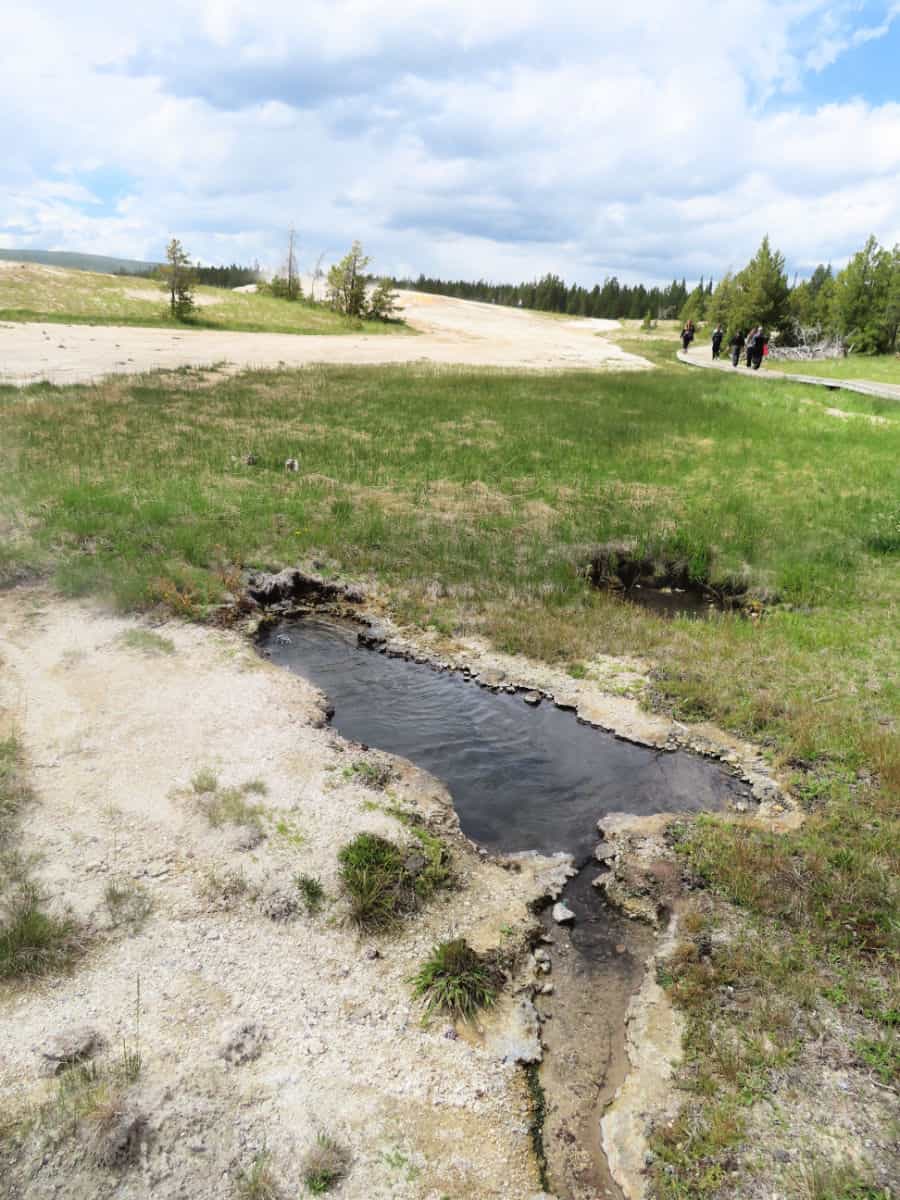
Additional Yellowstone National Park Resources
Yellowstone National Park Guide - Your complete guide to exploring the world's first National Park!
Things to do in Yellowstone - These are the top things to do that you don't want to miss, including exploring the Mammoth Hot Springs, the Museum of the National Park Ranger, Yellowstone Waterfalls, Kayaking in Yellowstone, fishing in Yellowstone, Fairy Falls Trail, and more!
Yellowstone National Park Facts - Learn more about our 1st National Park and fun facts about the wildlife in the park.
Yellowstone Wildlife Guide- Complete Guide to seeing wildlife in Yellowstone National Park, including the most popular wildlife viewing areas, including Lamar Valley and Hayden Valley.
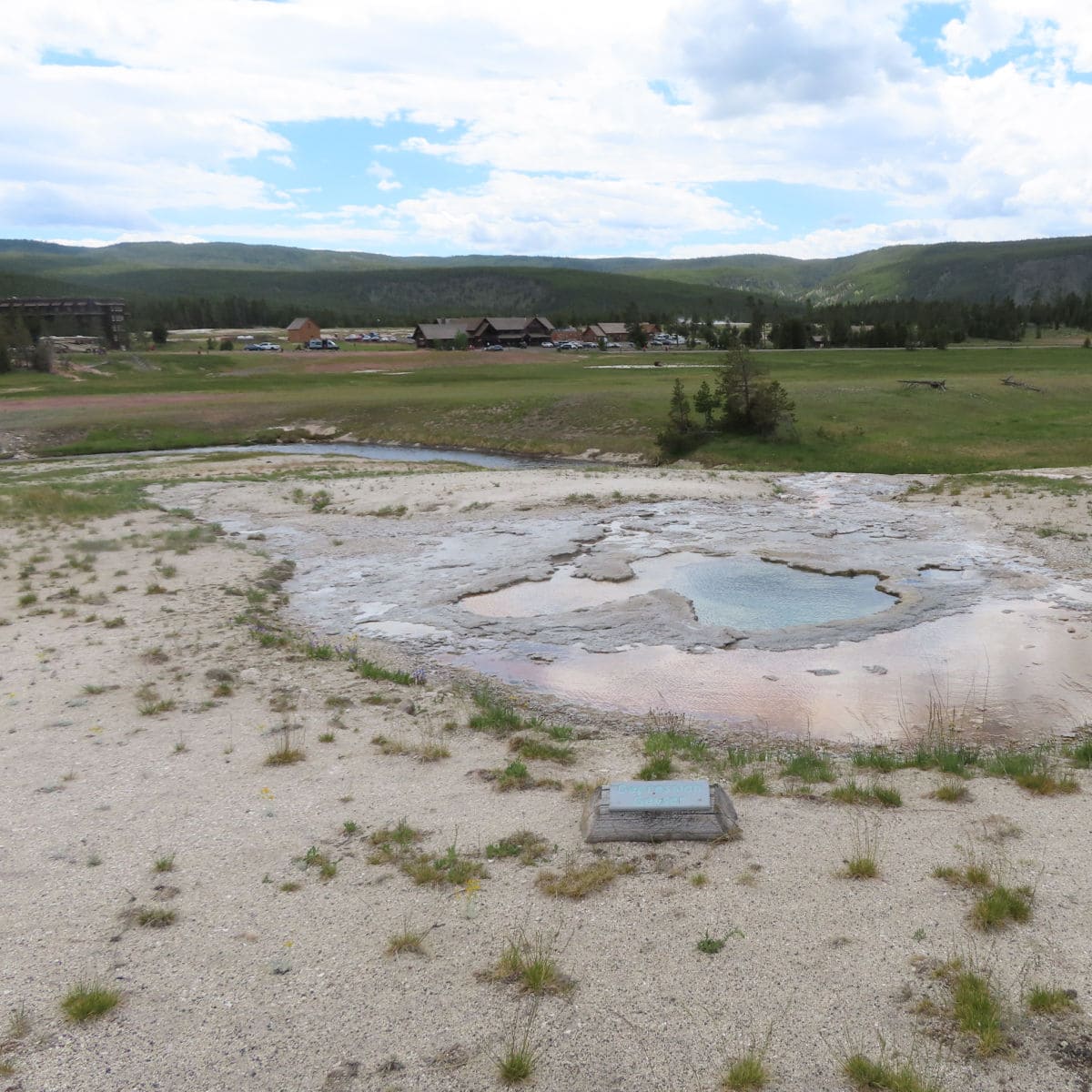
Yellowstone Geyser Basin Areas
Upper Geyser Basin, including Biscuit Basin, Black Sand Basin, and Old Faithful Geyser.
Midway Geyser Basin, including Grand Prismatic Spring and Firehole Lake Drive.
Lower Geyser Basin, including Fountain Paint Pot Trail and Firehole Canyon Drive
Norris Geyser Basin—This basin is known for having some of the hottest water and springs in the park. It is actually two basins: Porcelain Basin and Black Basin, with famous geysers, including Ledge Geyser, Cistern Geyser, and Steamboat Geyser.
West Thumb Geyser Basin - Beautiful boardwalk trail with hydrothermal features right next to Lake Yellowstone!
Mud Volcano - The Mud Volcano area is Located south of Canyon Village and North of Lake Yellowstone. It has several hydrothermal features, including a mud volcano and Dragon's Mouth Spring.
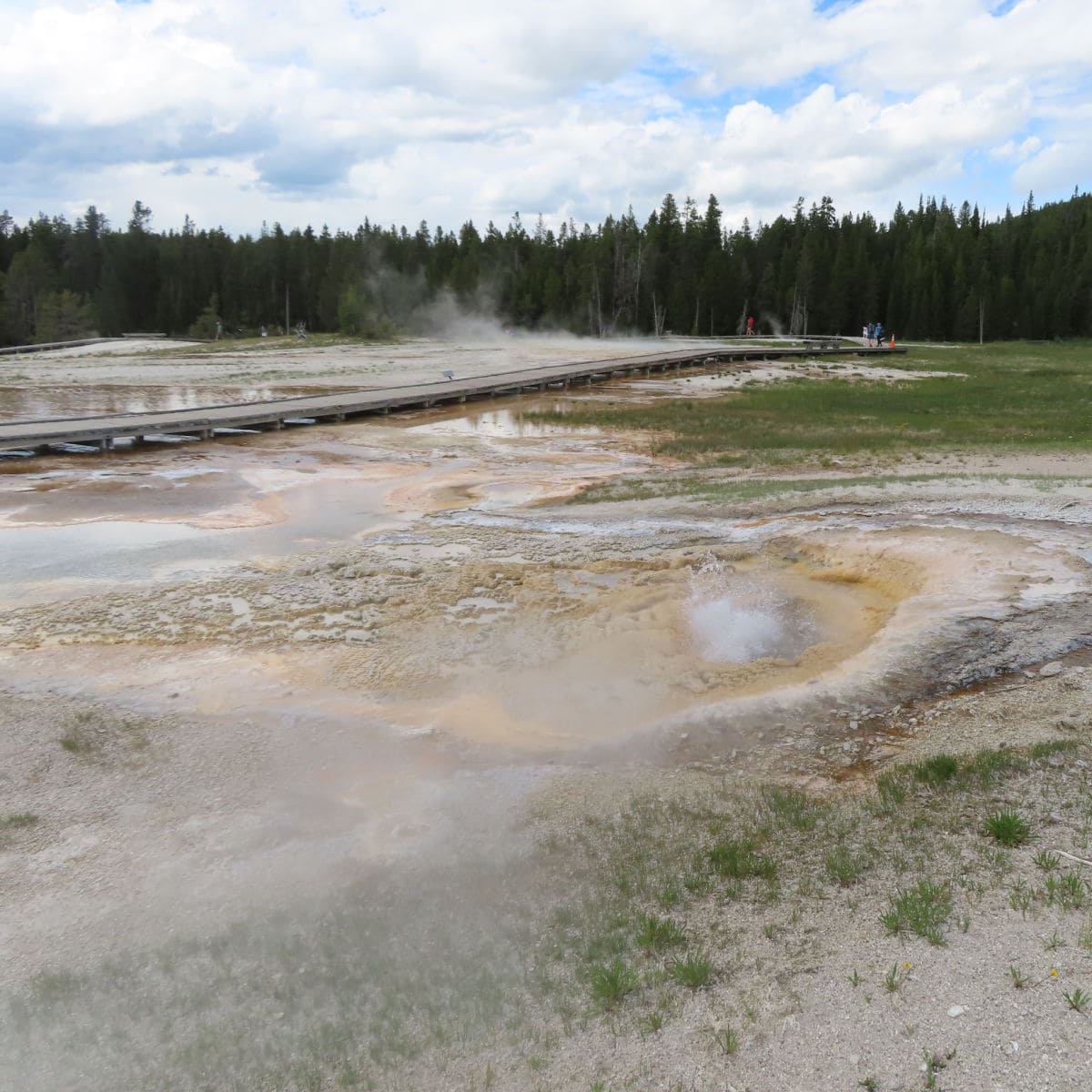
Yellowstone Camping Resources
Ultimate Yellowstone Camping Guide - This complete guide to camping in Yellowstone includes all front country campgrounds including: Bridge Bay Campground, Canyon Campground, Fishing Bridge RV Park, Grant Village Campground, Indian Creek Campground, Lewis Lake Campground, Madison Campground, Mammoth Campground, Norris Campground, Pebble Creek Campground, Slough Creek Campground, and Tower Fall Campground.

For a fun adventure check out Escape Campervans. These campervans have built in beds, kitchen area with refrigerators, and more. You can have them fully set up with kitchen supplies, bedding, and other fun extras. They are painted with epic designs you can't miss!
Escape Campervans has offices in Vancouver, Seattle, Portland, San Francisco, Las Vegas, Los Angeles, Phoenix, Salt Lake City, Denver, New York, and Orlando
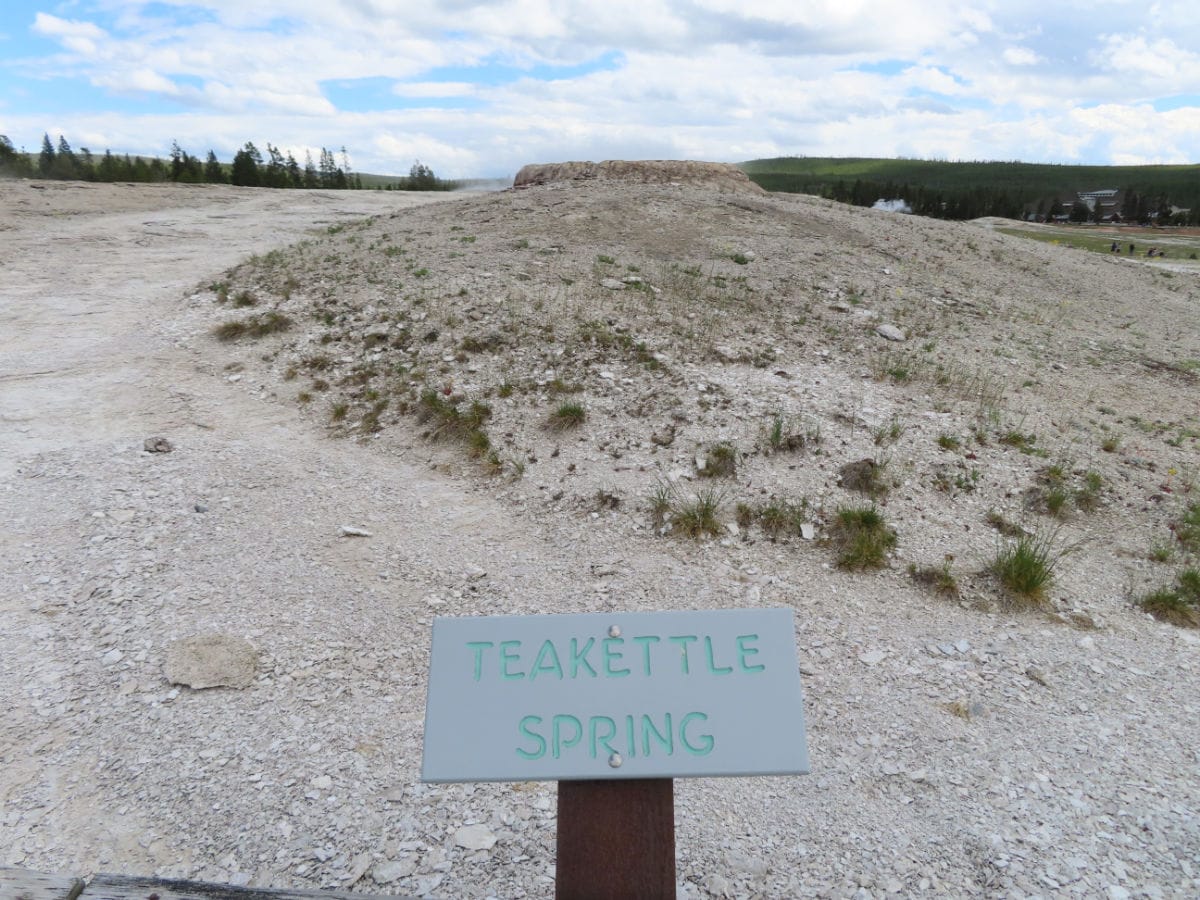
Where to stay when visiting Yellowstone National Park
When planning where to stay while vacationing in Yellowstone you will want to determine which area of the park you are planning to visit.
We suggest if possible staying at a few different lodging options to provide easy access to different portions of the park.
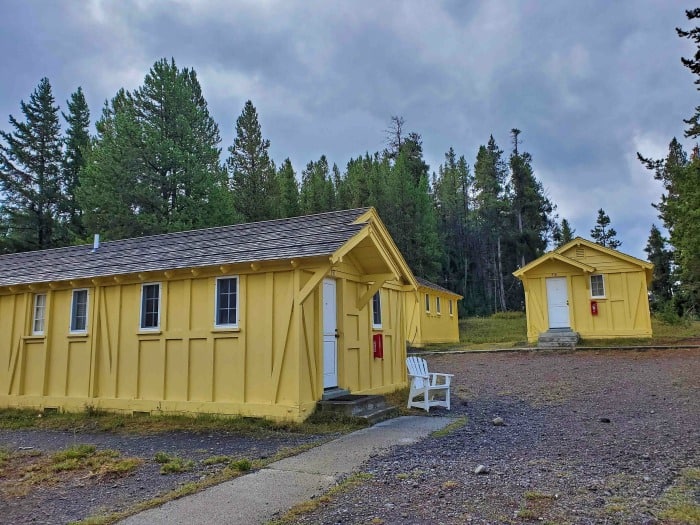
Yellowstone National Park Lodging
There are nine National Park Lodges located within the park offering over 2,000 rooms.
Only two lodges are open during the winter - Old Faithful Snow Lodge and Mammoth Hot Springs Hotel.
From late spring through fall all of the lodges are open.
- Canyon Lodge and Cabins: 400+ guest rooms spread across 5 hotel-style lodges, with 100+ cabins being more rustic accommodations. Available to book on Expedia
- Grant Village Lodge: 300 guest rooms spread across 6 two-story, hotel-style lodges. Available to book on Expedia
- Lake Hotel and Cabins: Large lodge that has hotel room-style and cabin accommodations. Available to book on Expedia
- Lake Lodge Cabins: 186 cabins.
- Mammoth Hot Springs Hotel and Cabins: Large lodge that has hotel room-style and cabin accommodations.
- Old Faithful Inn: Rustic lodge with hotel room-style accommodations. Available to book on Expedia
- Old Faithful Lodge: Cabin accommodations.
- Old Faithful Snow Lodge: Large lodge that has hotel room-style and cabin accommodations. Available to book on Expedia
- Roosevelt Lodge: Cabin accommodations.
Lodging near Yellowstone NP
Gray Wolf Inn & Suites in West Yellowstone - 3-star hotel. Gray Wolf Inn & Suites is located close to Yellowstone Park West Entrance, and provides a firepit, laundry facilities, and a 24-hour gym. Adventurous travelers may like the snowmobiling at this hotel. For some rest and relaxation, visit the hot tub. Free in-room Wi-Fi and a business center are available to all guests.
Stage Coach Inn in West Yellowstone - Yellowstone Park West Entrance is located near Stage Coach Inn, which provides free continental breakfast, laundry facilities, and a fireplace in the lobby. For some rest and relaxation, visit the sauna. Free in-room Wi-Fi is available to all guests, along with a gym and a 24-hour business center.
Yellowstone Westgate Hotel in West Yellowstone - At Yellowstone Westgate Hotel, you can look forward to free continental breakfast, laundry facilities, and a fireplace in the lobby. For some rest and relaxation, visit the hot tub. Free in-room Wi-Fi and a business center are available to all guests.
Brandin' Iron Inn in West Yellowstone - Brandin' Iron Inn is located close to Yellowstone Park West Entrance, and provides free full breakfast, laundry facilities, and a fireplace in the lobby. Skiers and snowboarders can spend time on the slopes at this motel offering ski-in/ski-out access and cross-country skiing. Guests can connect to free in-room Wi-Fi.
Kelly Inn West Yellowstone - Close to Yellowstone Park West Entrance, Kelly Inn West Yellowstone provides free continental breakfast, a free roundtrip airport shuttle, and a firepit. For some rest and relaxation, visit the hot tub. Free in-room WIFI is available to all guests, along with laundry facilities and a business center.
Dreamcatcher Tipi Hotel near Gardiner, MT- Along with self parking, this campground has coffee/tea in a common area and a microwave in a common area. Free continental breakfast and free Wi-Fi in public areas are also provided. Additionally, concierge services, a garden, and barbecue grills are onsite. All 17 accommodations boast heated floor (bathroom) and offer Wi-Fi and 8 bathrooms. Other amenities available to guests include memory foam beds, premium bedding, and rainfall showerheads. Private bathrooms are not ensuite.
Absaroka Lodge near Gardiner, MT- Absaroka Lodge provides amenities like a terrace and a garden. Stay connected with free in-room Wi-Fi.
Yellowstone Big Rock Inn near Gardiner, MT- Yellowstone Big Rock Inn provides a garden and more. Stay connected with free in-room Wi-Fi.
Super 8 by Wyndham Gardiner near Gardiner, MT- Super 8 by Wyndham Gardiner/Yellowstone Park Area provides dry cleaning/laundry services and more. Guests can connect to free in-room Wi-Fi.
Yellowstone Gateway Inn near Gardiner, MT- 3-star hotel near Yellowstone National Park. Yellowstone Gateway Inn provides amenities like a garden and laundry facilities. Treat yourself to a massage or other spa services. Stay connected with free in-room Wi-Fi.
Click on the maps below to see additional hotels and vacation rentals near Yellowstone NP.
Parks near Yellowstone National Park
Grand Teton National Park
Complete Guide to Grand Teton National Park - Your complete guide to go explore Grand Teton National Park before or after you visit Yellowstone!
Grand Teton Camping Guide - Complete Guide to all of Grand Teton National Parks campgrounds.
Grand Teton Lodging Guide - Complete Guide to all of Grand Teton's Lodges.
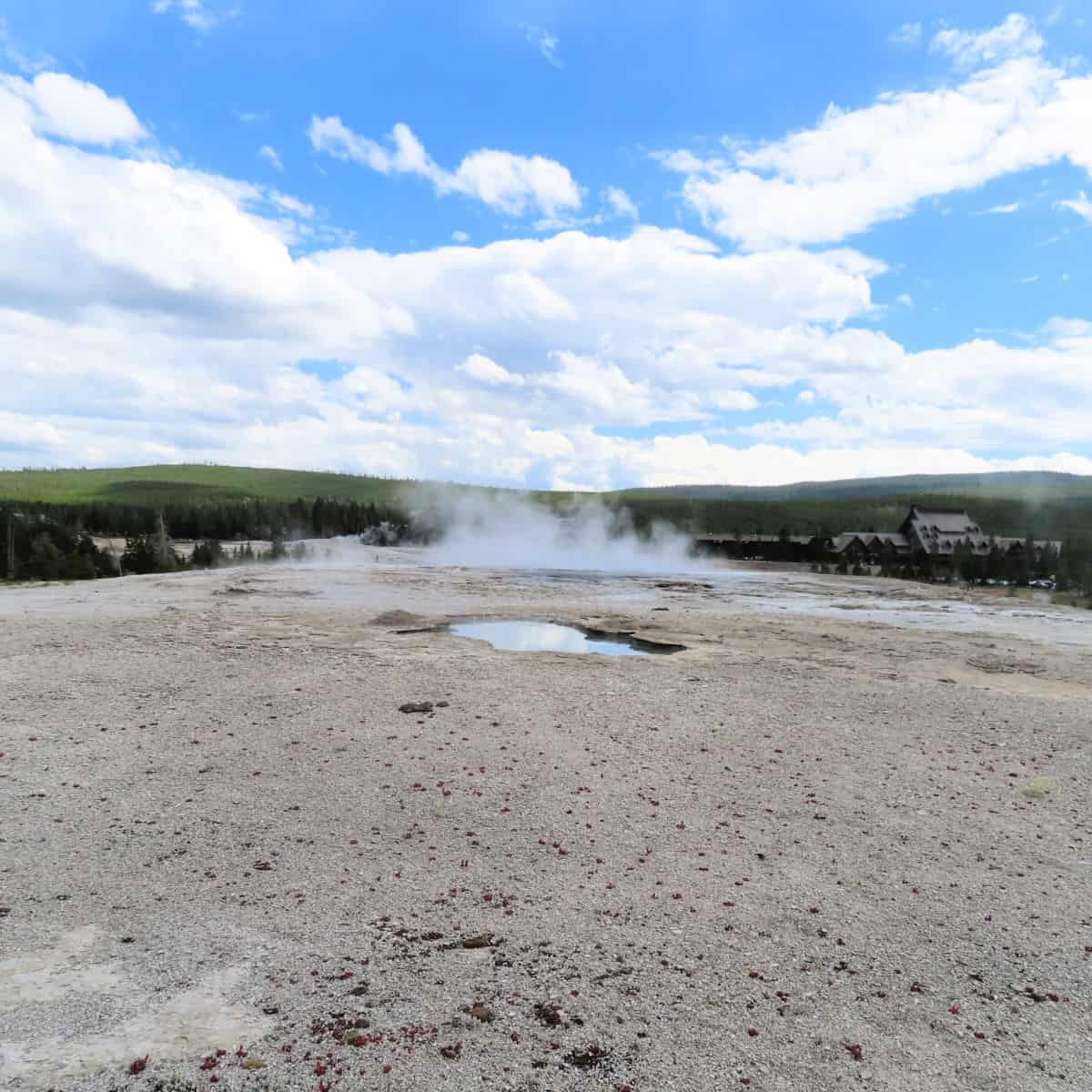
Glacier National Park
Epic Guide to Glacier National Park - Complete guide to exploring Glacier National Park
Glacier National Park Camping Guide - Complete Guide to all of Glacier National Park front country campgrounds
Glacier National Park Lodging Guide - Complete Guide to Glacier National Park Lodges
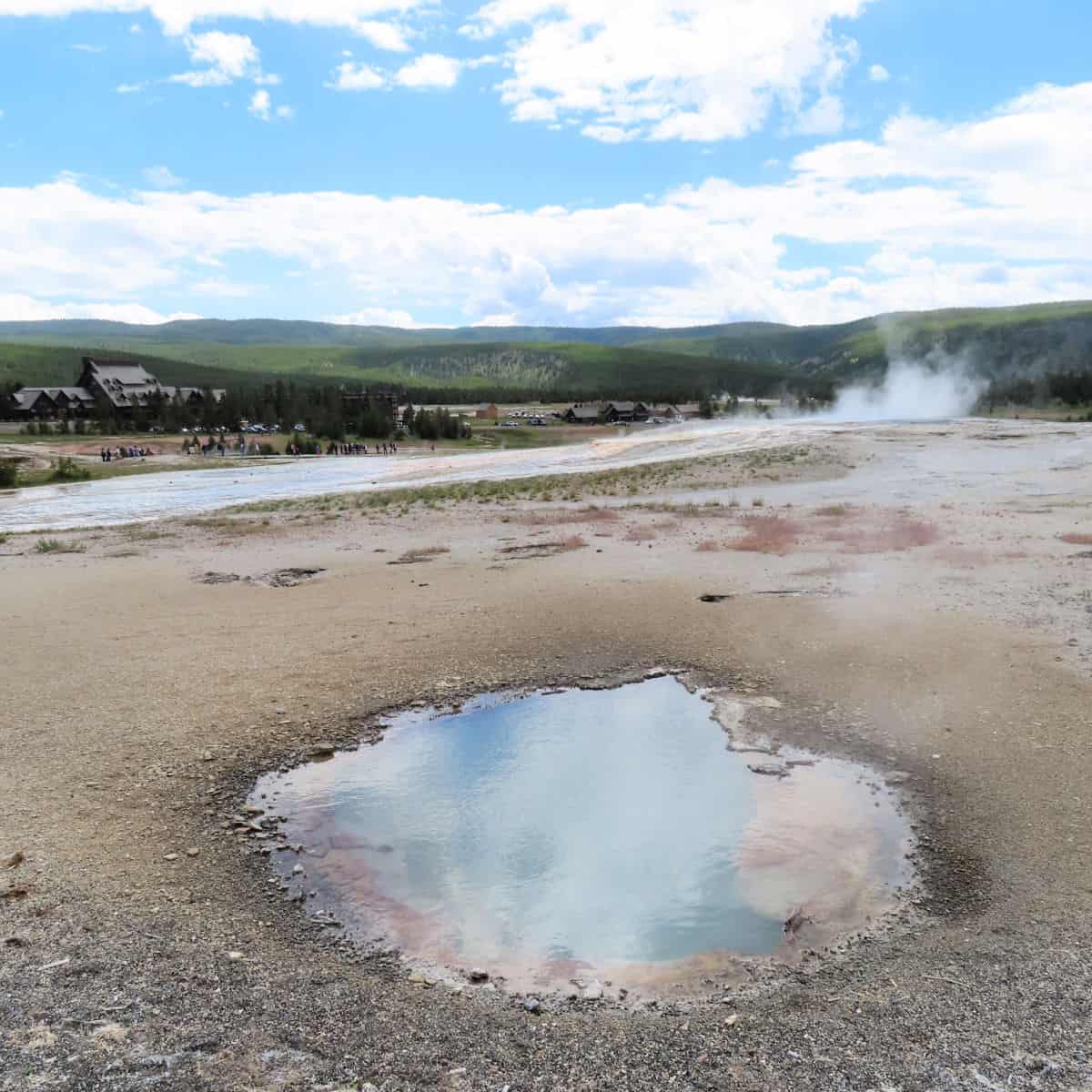
Additional Montana National Parks
Little Bighorn Battlefield - Also known as Custer's Last Stand, a place where the Plains Tribes fought their last major battle and won.
Big Hole National Battlefield - site of the pivotal battle in the Nez Perce War of 1877 between Colonel Gibbon's troops and five bands of the Nez Perce Indians led by the famous Native American Leader, Cheif Joseph.
Grant Kohr's Ranch National Historic Site - See what ranch life was like in the 1800s in Montana
Make sure to follow Park Ranger John on Facebook, Instagram, Pinterest, and TikTok





Leave a Reply